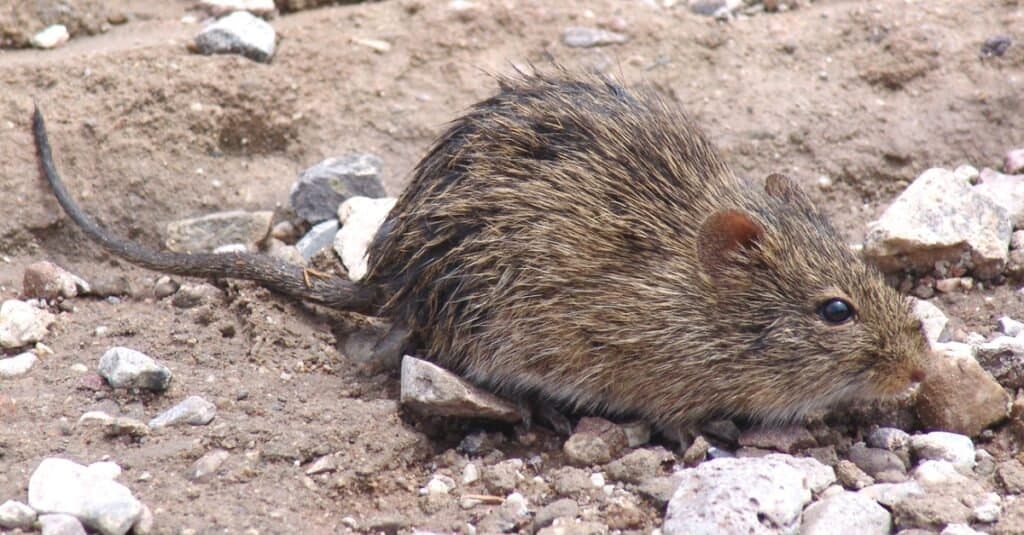Woodrat
Neotoma cinerea
Pack rats love shiny objects and will steal your jewelry.
Advertisement
Woodrat Scientific Classification
- Kingdom
- Animalia
- Phylum
- Chordata
- Class
- Mammalia
- Order
- Rodentia
- Family
- Cricetidae
- Genus
- neotoma
- Scientific Name
- Neotoma cinerea
Read our Complete Guide to Classification of Animals.
Woodrat Conservation Status
Woodrat Facts
- Prey
- insects
- Name Of Young
- Pinkie, pup, kitten
- Group Behavior
- Solitary
- Fun Fact
- Pack rats love shiny objects and will steal your jewelry.
- Biggest Threat
- Habitat destruction, disease
- Most Distinctive Feature
- bushy tail on some species
- Other Name(s)
- Packrat, trade rat
- Gestation Period
- 30 to 36 days
- Litter Size
- 1-5
- Habitat
- Deserts, mountains, caves, cliffs, woodlands, human habitations
- Predators
- Birds of prey, humans, foxes, weasels, bobcats, coyotes, skunks, snakes
- Diet
- Herbivore
- Type
- mammal
- Common Name
- woodrat
- Number Of Species
- 17
- Location
- North America
- Group
- solitary
Woodrat Physical Characteristics
- Color
- Brown
- Grey
- Black
- Skin Type
- Fur
- Top Speed
- 8 mph
- Lifespan
- less than five years
- Weight
- 9.5 to 14 ounces. Males are bigger and heavier than females.
- Length
- 10 to 18.5 inches
- Age of Sexual Maturity
- 60 days
- Age of Weaning
- 14 to 42 days
View all of the Woodrat images!
“The woodrat is the collector of bright and shiny objects.”
The woodrat, also called the packrat or the trade rat, is famous for picking up or even stealing man-made objects and using them to build its nests and dens. The accumulated trash thrown out of these dens over time can tell scientists the history of a place.
5 Incredible Woodrat Facts!
Here are four facts about the packrat:
- Some packrat middens are 50,000 years old, and scientists study them for the effects of climate change and other phenomena.
- Along with bright shiny objects, packrats have been known to take the feces of other animals back to their nests. Pathogens in the feces are believed to cause disease in the rats.
- The bushy-tailed woodrat is the largest of the woodrats. It has a bushy tail, can be mistaken for a squirrel and is more cold tolerant than other woodrats.
- The presence of other males inhibits a male dusky-footed woodrat’s sexual maturation. When he’s by himself, he achieves sexual maturity.
- Unlike the city rats Rattus norvegicus and Rattus rattus, packrats are native to North America.
Scientific Name
Packrats belong to the Neotoma genus. Neotoma comes from the Greek words for “new,” neos, and “cut,” tomos. So, Neotoma refers to a new mammal with teeth that cut. Originally, packrats were placed in the Mus genus, which simply means mouse. Species are:
- N. albigula
- N. angustapalata
- N. chrysomelas
- N. cinerea
- N. devia
- N. floridana
- N. fuscipes
- N. goldmani
- N. lepida
- N. leucodon
- N. macrotis
- N. magister
- N. melanura
- N. mexicana
- N. micropu
- N. nelsoni
- N. palatina
- N. phenax
- N. stephensi
Some of these species have subspecies. For example, the desert woodrat, N. lepida has 23 subspecies.
Appearance
The packrat resembles the Norway rat that’s often seen in cities but is somewhat more aesthetically pleasing. Its fur ranges from cinnamon to grayish-brown to brown, and its undersides are always white or light gray. The packrat’s eyes are large and dark, and one means of identification is its tail. The trade rat’s tail is furry, while the city rat’s tail is scaly. It can be nearly as bushy as a squirrel’s. T
he packrat has a long body and large, round ears. Its size depends largely on its location, for packrats from warmer climates tend to be smaller than those from cold climates. Hence, the bushy-tailed woodrat is the largest of these rodents and is found as far north as Canada’s Yukon Territory. Packrats range from 10 to 18.5 inches in length and weigh between 9.5 to 14 ounces, though some individuals are larger. Male packrats are larger than females.

©iStock.com/rtrible
Behavior
Woodrats are solitary and only come together to mate. The only other type of group behavior involves a mother and her pups. Most species appear to be nocturnal though it’s not unheard of to see some types of woodrat, such as the white-throated woodrat, being active during the day. Identification of a packrat, as opposed to another rodent, also comes from their habit of building nests and dens out of all manner of materials, including plant material, bones, feathers, animal feces, and man-made objects. Indeed, if a packrat is carrying a twig and finds a shiny penny in its path, it will drop the twig, pick up the penny and take it to add to its nest. This is how they get their other name of trader rat.
Packrats communicate with each other through their scent glands, which are especially well-developed in males. Their scent glands are found in the middle of their bellies, and they drag themselves over the ground to lay down their scent. Their feces also have pheromones that allow the identification of males and females. Packrats tend to be aggressive in defending their territory. Because packrats don’t hibernate, they cache food in different locations around their territories.
Woodrats are also famous for middens, which can be enormous and tens of thousands of years old. They are not dens or nests, though nests and dens are built within them. Nests are kept clean and tidy, but middens have years, centuries, and millennia of waste products that scientists use rather like time machines to determine how the climate has changed and the types of plants that used to grow in the area.
Habitat
Packrats are native to North America, and biologists believe they have been on the continent for tens of thousands of years just from the age of the oldest middens. They build their nests and dens in deserts beneath spiny cacti, in caves, on cliffs, up in trees, in houses where people live, and in abandoned buildings and mines. They’re found in the woods, chaparral, on mountain ridges, and near bodies of water, including lakes rivers, and oceans. Some dens passed down from mother to daughter, as can be seen in the big-eared woodrat.
Diet
Packrats are herbivores and eat acorns, leaves, pine needles, seeds, and succulents. A few species are specialists and only eat juniper, yucca, and certain species of cacti.
Predators and Threats
As a rat, the packrat has a variety of predators, including skunks, weasels, owls, coyotes, black bears, foxes, snakes, and humans.
Many species of packrats, including the Allegheny woodrat, are subject to diseases. The Allegheny woodrat’s population seems to be negatively affected by the raccoon roundworm. Packrats are also hosts to ticks, mites, fleas, roundworms, and botflies.
Reproduction and Life Cycle
The mating rituals of these little mammals are mysterious to biologists, but a lot of species fight before they mate. These are not play fights. The male and female packrat will stand on their hind legs and box like kangaroos and bite and scratch each other. It is not unusual for one or both to be injured, and if the female is bigger and stronger, the male can be killed. It seems the pair mates when they get tired of fighting. Mating happens quickly in most species because the pair is vulnerable to predation when they’re in the act. Afterward, the male leaves and attempts to breed with another female.
The breeding season for some packrats is in spring and summer, though it is the fall for the Allegheny woodrat and from February to August for the eastern woodrat. The female is pregnant for a little over a month. The size of the litter ranges from one to six babies, even though the packrat has only four teats. The babies are hairless and blind. At this stage, they’re called “pinkies.” Their eyes open when they’re about two weeks old, and they’re weaned after bout a month. The males leave when they’re about two and a half months old, but the females often share territories with their mother, and as stated daughters inherit their mother’s dens in some species. Mothers and daughters may also use the same food caches.
The pups are sexually mature when they’re about two months old, but they don’t breed until they’re a year old. The lifespan of a packrat rarely lasts as long as five years, and most have a lifespan of less than three. The entire population is believed to turn around every eight years. Interestingly, some species of packrats are not as prolific breeders as other types of rats and mice. The Allegheny woodrat can have two or three litters of two pups every year, which is a low birth rate.
Population
The overall packrat population is undetermined, but there are at least hundreds of thousands. Some species are of least concern but others are in decline and considered vulnerable. For example, the Allegheny woodrat is considered endangered in some of its range, although its population is estimated at around 100,000. Subspecies of the eastern woodrat are considered endangered or threatened in Key Largo, Florida, North Carolina, and Tennessee.
View all 108 animals that start with WWoodrat FAQs (Frequently Asked Questions)
Are woodrats carnivores, herbivores, or omnivores?
Woodrats have an herbivorous diet and eat seeds, twigs, shoots, leaves, mushrooms, pine needles, and succulents. Once in a great while, they might eat an insect.
Are woodrats dangerous?
Woodrats can be troublesome if they get into a house and start to chew on electrical wiring or tear up upholstery or carpeting to line their nests. The detritus from their nests also harbor disease vectors such as fleas and the terrible kissing bug. The waste also smells bad.
Are woodrats protected?
Some woodrats are protected. The Allegheny woodrat is protected, as is the dusky-footed woodrat. This packrat has 11 subspecies and is listed as endangered.
What is a woodrat?
A woodrat or packrat is a rodent that belongs to the Neotoma genus. They have big black eyes, furred tails, and love to collect trinkets.
How do I catch a bushy-tailed woodrat?
The best way to catch a bushy-tailed woodrat is to set out a humane rat trap with a shiny object inside of it. The animal will find it irresistible, and when it enters the trap the door will shut behind it.
What do woodrat droppings look like?
They are 1/2 inch long, dark-colored oval pellets. Since a packrat drops these pellets 40 to 50 times a day, it can make quite a mess in a home.
How do you get rid of woodrats?
You can trap the rodent as described above then release it into the woods, or call a professional.
What are woodrats good for?
Woodrats are native to North America and have evolved along with their ecosystems. They are food for predators and disburse seeds, so ideally they shouldn’t be killed unless there’s a truly intolerable infestation in the home.
Are woodrats harmful?
Packrats can be harmful if there come to be too many of them living in an area. Their middens attract disease-carrying creatures and a bad infestation can interfere with crop production on a farm, even though this is rare.
Thank you for reading! Have some feedback for us? Contact the AZ Animals editorial team.
Sources
- Wikipedia / Accessed December 18, 2021
- Center for Humans & Nature / Accessed December 18, 2021
- ITIS / Accessed December 18, 2021
- Britannica / Accessed December 18, 2021
- dreamstime / Accessed December 18, 2021
- NatureServeExplorer / Accessed December 18, 2021
- Earth's Endangered Creatures / Accessed December 18, 2021
- The National Wildlife Federation / Accessed December 18, 2021


















